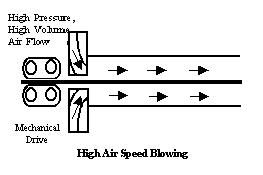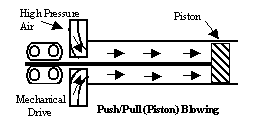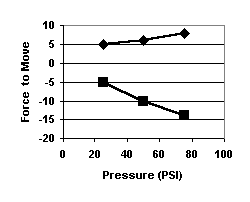| |
|||||||||
| |
|
|
|
|
|
|
|
||
| Home | About | Literature | Site Map | MSDS | Contact | Engineers | Shows | Links | Samples | RFQ | Catalog Numbers |
High Air Speed Blowing, Air-Assist, Push/Pull Installation, Air Blown Cable, and Cable Jetting; all describe new methods to get cable into conduit using air. To date, the primary use of these methods has been to install fiber optic cable.
Air-assisted fiber optic installation was developed and explored in the Netherlands as well as the United Kingdom in the 1980ís. While blowing methods are used to install individual fibers in tubes in LANís, this article will focus on the outside plant installation of jacketed, multi-fiber cable in duct. While this is typically underground duct, blowing will work for aerial duct installations as well.
What is Air Blowing?
Outside plant personnel are very familiar with the pulling method of installing cable. Thread a line through the duct, attach the line to the cable, and pull or tug the cable through the duct. The force needed to pull the cable usually comes from a capstan or hand-over-hand pulling of the rope. This force is needed to overcome the cableís frictional resistance to movement. Length of installation is limited by the maximum force allowed on the cable.
Air-assisted installation must overcome the same frictional force to move cable, but it does this in a very different way. The force in air blowing first comes from a mechanical device which pushes the cable; and second, from the force of moving air on the cable jacket, or alternatively, the force of air on a piston, missile, or carrier at the front end of the cable.
These two variations of air blowing are diagrammed below:


While the pushing device is common in both methods, the purpose of the airflow through the conduit is different. In the high air speed blowing (HASB) method, the conduit is wide-open, and high air volume (300-600 cfm) blows through it. This "wind" pushes on the cable and advances it forward at whatever speed the pusher will support. There is no pulling force on the front end of the cable, only a mechanical pushing force at the back and an air drag force distributed along its length.
The piston (push/pull) method attaches a missile or carrier to the front of the cable. The missile is pushed through the conduit by the air pressure force, and the missile pulls on the cable, thus the term push/pull installation. Because the conduit is blocked, or at least partially blocked, by the piston, this method does not require as much air flow as the high air speed method, and flows of 200 to 300 cfm are typical during push/pull piston installation.
Fiber Optic Pulling Vs Blowing
While all types of cable can be blown into duct, blowing is particularly useful for placing outside plant fiber optic cable. Fiber optic cable is lightweight and flexible. Long, uninterrupted lengths of installed cable are desired. Both these factors play to the strengths of the blowing methods.
In pulling, when a cable goes through a conduit bend, the pulling force on the cable actually pulls the cable into the bend. An exponential frictional force is created that is many times greater than what would occur with just the weight of the cable. Thus, an accumulation of bend angles greatly reduces possible pull length. But cross-country fiber optic pulls donít have a lot of bends, or do they?

Continuous flexible duct introduces "hidden bends." These are inherent undulations or waves from reel memory as sketched here.
While these waves can be minimized, they canít be completely eliminated. Typical displacements of a few inches to a foot increase pulling tension by factors of 3 to 200. Reference [1] presents theoretical detail on the duct wave effect and its magnitude.
Maximizing distance in fiber optic pulling means minimizing duct undulations. Thick walled innerduct with a diameter of 2 inches or more can be placed "straighter" than 1 inch or 1.25 inch duct, but at a cost premium. Multi-cell ducts keep innerducts straight with a rigid exterior, again with a cost and labor add-on. Plowed duct is straighter than trenched duct. In fact, pulling cable into open trenched innerduct is not practical. The amount of undulation simply makes pull lengths too short.
Duct bends, including undulations, do not limit blowing processes, especially HASB, as much as they do traditional cable pulling. In HASB, the cable is not pulled into the bend by a large pulling force, but rather pushed through the bend by a lower, local air pushing force.
In push/pull blowing, the pulling from the piston is partially offset by the pushing force from the mechanical pusher. This somewhat offsets the effects of bends. A more detailed analysis of the bend performance differences in HASB versus push/pull can be found in [2].
Keys in Air-Assisted Installation
To get the best performance in blown installations, there are several important factors to control. First is the flexibility of the cable. A cable that is too flexible cannot be pushed properly without bunching up. While stiffer cables are easy to push, they consume more force bending and unbending through conduit bends.
Choosing the proper cable is important for optimal blowing. Although most fiber cables can be blown, some cables are designed specifically for blowing. Consult your cable manufacturer for recommendations.
Type of duct is another significant factor in optimized blowing. Ducts with circumferential ribs or corrugations that disrupt the flow of air are not satisfactory. Smoothwall and longitudinal ribbed HDPE conduits are preferable [3].
Just as important as the type of duct is its ability to hold air pressure. The duct must hold up to 130 psi of air without leaks. Duct splices are critical. Splices must not reduce the interior diameter of the duct. Innerduct couplers specially designed for the blowing process are commercially available and recommended.
Friction Reduction
A final factor in optimized blowing is friction reduction. Theoretically, the maximum length that can be blown in any situation is proportional to the coefficient of friction. If the coefficient of friction can be reduced by a factor of three, the practical length of installation will go up by three.
Lubrication is critical in optimized air blowing. Good quality factory lubrication on the duct interior is helpful. But the most consistent results come from field application of specially engineered blowing lubricants, such as American Polywater's Prelube™ 2000. Cable pulling lubricants such as Polywater® F do not work well for blowing, and special blowing lubricants are recommended. Generally, blowing lubricants are used in relatively small quantities (3-10 fluid ounces per thousand feet).

Some research results on lubrication in the blowing process [4] are presented in the graph on the right. In these studies, the mechanical pushing unit was deactivated on an HASB machine, and the forces on a cable were measured at various air pressures and volumes. The moving air was pushing an MDPE jacketed fiber cable that was fully threaded through a multi-looped HDPE smoothwall innerduct.
The graph shows a lubricated coefficient of friction in the 0.08 range versus the 0.60 range for the unlubricated cable. For straight installations, this level of lubrication could result in more than a factor of 5 increase in installation length.
Air pressure (psi) is plotted on the x-axis and the force (lbs f) required to move the cable on the y-axis. A negative force indicates the cable was trying to advance into the conduit and had to be held back.
Field Comparison and Economics
Blowing processes generally install cable into duct at a higher speed than pulling. Economics can be favorable, especially on large jobs where the cost of equipment can be amortized. Field crews report as much as 50,000 feet of cable installed per day. General cost factors are presented below:
| PULLING | BLOWING | |
|---|---|---|
| Equipment | 1 - 12 M $ | 15 - 45 M $ |
| Speed | 75 - 200 fpm | 200 - 350 fpm |
| Length | 1500 - 3500 ft | 3000 - 8000 ft |
| Pull Line | Required | Not Required |
Long, uninterrupted lengths of blown cable can be installed by cascading blowing units. This cascading, or using the units in series to make continuous runs, can minimize the need for figure-eighting.
Blowing requires good planning and preparation, especially duct preparation. All of the units require seals sized to the cable to prevent leakage from the pressure chamber around the entering cable. Properly sized seals should be obtained before starting the job.
General Field Procedures
Summary
Air-assisted installation of fiber optic cable has proven to be both practical and economical. The technology is not only gaining popularity in the USA and Europe, but throughout the world. The process is quite different from pulling and requires a focus on different factors than pulling. An installer can quickly learn and use air-assist methods by attending to these factors.
References
[1]"Analysis of Duct Displacement Factor in Fiber Optic Pulling." J. M. Fee et al, 1997
[2]"Installation of Fiber Optic Cables in Duct," W. Griffioen, Plumettaz S. A., 1993
[3]"The Use of the High Air-Speed Blown-Cable System for Placing Optical-Fiber Cables in Ducts," P. R. Briggs et al, NFOEC Conference, 1993
[4]"Analysis and Measurement of Friction in High Speed Air Blowing Installation of Fiber Optic Cable," J. M. Fee et al, NFOEC Conference, 1995
View this flyer En Español
Click here to Add Your Name To Our Mail List
Click here to view the TeleTopics Newsletter article on cable blowing
Home |
About |
Site Map |
Literature |
Samples |
Links |
Reps |
Videos |
Pumps |
RFQ
Codes |
Engineering |
Shows |
Spotlight |
Newsletters |
MSDS |
Translations |
Contacts |
Jobs

11222 60th ST N | Stillwater, MN 55082-9310 USA
1-(651) 430-2270 (Voice) | 1-(651) 430-3634 (Fax)
1-(800) 328-9384 (Toll-Free US/Canada Only)
Copyright © 2001 - 2015 American Polywater Corporation | ![]() 6/5/15
6/5/15